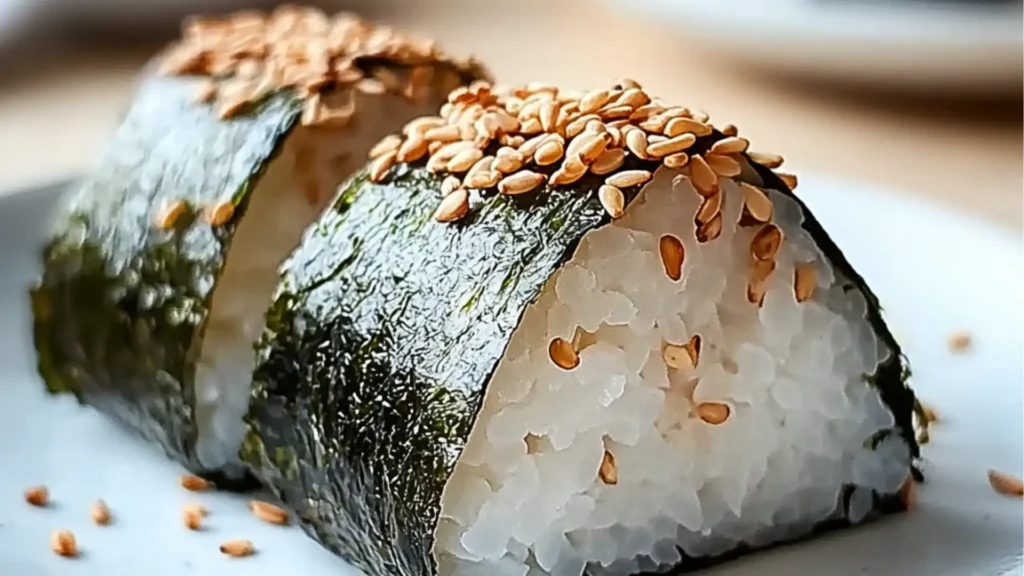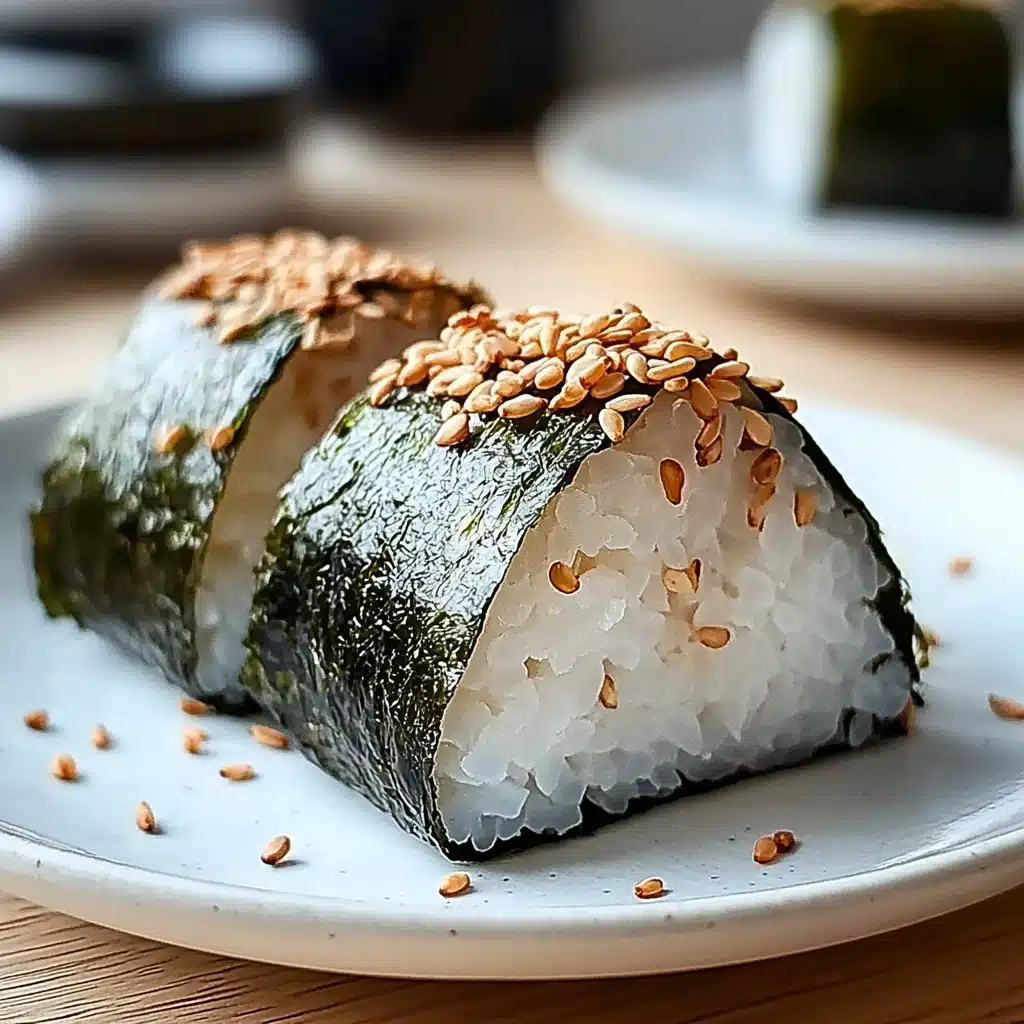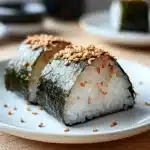When it comes to easy to make Japanese food, few dishes are as iconic, versatile, and comforting as onigiri. These simple rice balls wrapped in nori (seaweed) and filled with flavorful ingredients are a staple in Japanese households. Today, we’ll explore one of the most popular variations: Japanese Tuna Onigiri with creamy mayo filling.
Loved by children, students, and busy professionals alike, this dish is quick to prepare, portable, and endlessly customizable. Whether you’re looking for easy food for school, a grab-and-go breakfast, or a convenient travel lunch, tuna mayo onigiri is a recipe worth mastering.
Table of Contents
What is Onigiri in Japanese Cuisine?
In Japanese food culture, onigiri (おにぎり) simply means “rice ball.” Unlike sushi, which uses seasoned vinegared rice, onigiri is made with plain or lightly salted Japanese short-grain rice. The rice is shaped into triangles, rounds, or cylinders and filled with savory ingredients before being wrapped with a strip of crisp nori.
Why Onigiri Is Special in Japanese Food
- It’s one of the most quick Japanese meals you can prepare.
- It represents home cooking, comfort, and nourishment.
- You’ll find onigiri everywhere in Japan — from convenience stores and bento boxes to homemade lunchboxes.
Tuna mayo has become one of the most beloved modern fillings because it’s creamy, flavorful, and universally appealing, making it a favorite among kids and adults alike.
Why You’ll Love This Easy to Make Japanese Food
Here’s why Japanese Tuna Onigiri deserves a spot in your kitchen:
- Simple ingredients: All you need is rice, tuna, mayonnaise, and seaweed.
- Portable: Perfect for bento lunches, picnics, or travel lunch options.
- Budget-friendly: Uses pantry staples like canned tuna.
- Customizable: Can be adapted with different fillings or seasonings.
- Kid-approved: Great as easy food for school or snacks for picky eaters.
On busy mornings, onigiri doubles as a student breakfast idea and transitions seamlessly into a satisfying easy Japanese lunch idea.
Ingredients for Tuna Mayo Onigiri
For the Rice
- 2 cups uncooked Japanese short-grain rice (yields about 4 cups cooked rice)
- 2 ¼ cups water for cooking
- 1 teaspoon salt
For the Filling
- 1 can tuna (5 oz / 140g), drained
- 3 tablespoons Japanese mayonnaise (such as Kewpie)
- ½ teaspoon soy sauce (optional, for added flavor)
- ½ teaspoon rice vinegar (optional, for brightness)
For Assembly
- Nori sheets, cut into strips
- Bowl of salted water (for shaping rice)
- Extra salt for sprinkling on rice
Optional Additions
- Finely chopped green onions
- Sesame seeds for added crunch
- Pickled vegetables for tang
This basic ingredient list can be adapted to suit different easy Japanese meal prep preferences.
Kitchen Equipment Needed
You don’t need much to make this recipe, which makes it ideal for quick Japanese meals.
- Rice cooker (or a pot with lid)
- Mixing bowls
- Small spoon for filling
- Sharp knife for cutting nori
- Plastic wrap or onigiri mold (optional for beginners)
Step-by-Step Preparation Guide
Step 1: Cook the Rice
Rinse the rice under cold water until the water runs clear. Add rice and water to a rice cooker or pot and cook until fluffy. Allow the rice to cool slightly but keep it warm — warm rice sticks together best for shaping.
Step 2: Prepare the Tuna Mayo Filling
In a small bowl, combine drained tuna, Japanese mayo, and soy sauce. Mix well until creamy. Adjust seasoning to taste.
Step 3: Shape the Onigiri
- Wet your hands with salted water to prevent sticking.
- Scoop a handful of warm rice into your palm.
- Make a small indentation in the center and place 1–2 teaspoons of tuna filling inside.
- Cover with more rice and gently shape into a triangle, round, or oval. Don’t squeeze too hard — keep the rice grains fluffy.
Step 4: Wrap with Nori
Wrap a strip of nori around the base or the entire rice ball, depending on your preference.
Step 5: Serve or Pack
Enjoy immediately while the seaweed is crisp, or pack for later in bento boxes, as easy Japanese lunch ideas.
Tips for Perfect Japanese Tuna Onigiri
- Rice consistency matters: Always use Japanese short-grain rice — it’s sticky enough to hold shape.
- Shape gently: Don’t mash the rice; keep it firm but airy.
- Keep hands wet and salted: This prevents sticking and seasons the rice lightly.
- Nori freshness: Add nori just before eating if you want it crisp.
With these tips, your easy Japanese meal prep will yield restaurant-quality onigiri every time.
Variations of Easy Japanese Lunch Ideas
While tuna mayo is a classic, onigiri can be filled with many different ingredients:
- Salmon flakes for a traditional twist.
- Pickled plum (umeboshi) for a tangy bite.
- Seasoned vegetables for a vegetarian option.
- Miso-seasoned fillings for savory depth.
This flexibility makes onigiri one of the best easy Japanese lunch ideas and a go-to for quick Japanese meals.
Quick Japanese Meals with Onigiri
Onigiri isn’t just a snack — it can be the star of a complete meal. Pair it with:
- A bowl of miso soup for a comforting set.
- A side salad or pickles for crunch.
- A piece of fruit for balance.
For breakfast ideas with rice, serve tuna onigiri with a soft-boiled egg and miso soup.
Easy Japanese Meal Prep for Busy Days
Onigiri is perfect for easy Japanese meal prep. Here’s how to make it ahead:
- Shape rice balls and store in plastic wrap or airtight containers.
- Keep refrigerated for up to 2 days.
- Reheat by wrapping in damp paper towel and microwaving gently, or eat cold for convenience.
For longer storage, freeze onigiri without nori. When ready to eat, thaw and add fresh seaweed.
Breakfast Ideas with Rice
In Japan, rice-based breakfasts are common. Onigiri makes an excellent addition to student breakfast ideas because it’s:
- Filling and nutritious.
- Easy to eat on the go.
- Customizable with different fillings for variety.
Pair tuna onigiri with miso soup or tamagoyaki (Japanese rolled omelet) for a traditional morning meal.
Common Mistakes to Avoid
- Using the wrong rice: Long-grain rice won’t stick properly.
- Overstuffing: Too much filling can break the rice ball.
- Shaping cold rice: Rice must be warm to stick.
- Skipping salt water: This simple step seasons rice and prevents sticking.
How Tuna Onigiri Fits into Everyday Japanese Food
Onigiri is not just food — it’s cultural. In Japan, it represents comfort and care. Parents often make them for children’s school lunches, and travelers pack them for journeys.
Tuna mayo has become a modern favorite because it combines global flavors with traditional Japanese preparation, bridging cultures while keeping the dish’s essence intact.
For those exploring food in Japanese culture, onigiri is an essential introduction.
Frequently Asked Questions (FAQ)
Q1: Can I use canned tuna?
Yes, canned tuna is the most common choice and makes this recipe quick and affordable.
Q2: How do I keep seaweed crispy?
Wrap nori just before eating. If packing for school or travel, wrap nori separately and add later.
Q3: How long does tuna onigiri last?
Up to 2 days in the fridge. Freeze for longer storage without nori.
Q4: Can I use brown rice?
Yes, but it won’t stick as well as short-grain white rice.
Final Thoughts on Japanese Tuna Onigiri
This Japanese Tuna Onigiri is proof that simple ingredients can create something satisfying, delicious, and versatile. From easy food for school lunches to quick Japanese meals for busy evenings, onigiri is the ultimate easy Japanese meal prep dish.
Whether you enjoy it for breakfast, lunch, or a travel lunch on the go, it’s a recipe worth keeping in your weekly rotation.
PrintJapanese Tuna Onigiri: The Easy to Make Japanese Food You’ll Love
- Total Time: 45 minutes
- Yield: 6 onigiri 1x
Description
These Japanese Tuna Onigiri are creamy, portable rice balls filled with a savory tuna mayo mixture and wrapped in nori. A beloved staple of Japanese food culture, they’re quick, budget-friendly, and perfect for school lunches, breakfasts, snacks, or easy meal prep at home.
Ingredients
- 2 cups Japanese short-grain rice (sushi rice), cooked
- 1 can (5 oz) tuna, drained
- 2 tbsp Japanese mayonnaise (or regular mayo)
- 1 tsp soy sauce
- Nori (seaweed sheets), cut into strips
- Salt, for seasoning rice and hands
- Optional: sesame seeds or furikake for garnish
Instructions
- Cook rice: Prepare Japanese short-grain rice and let it cool slightly until warm.
- Mix filling: Combine drained tuna, mayonnaise, and soy sauce in a bowl until creamy.
- Shape onigiri: Wet hands with water, sprinkle with salt, and flatten 1/2 cup rice into a disk. Place a spoonful of tuna filling in the center and fold rice around it.
- Form shape: Gently press into a triangle or ball, applying light but firm pressure.
- Wrap with nori: Add a strip of nori around the rice ball.
- Serve: Enjoy immediately or wrap in plastic for later. Best consumed within a few hours if unrefrigerated.
Notes
- Use Japanese short-grain rice for best stickiness and texture.
- Season hands with salt to prevent sticking and lightly flavor the rice.
- Don’t overfill with tuna mayo to keep onigiri intact.
- Use fresh, crisp nori for best taste and texture.
- For meal prep, freeze without nori and add seaweed fresh when reheating.
- Prep Time: 20 minutes
- Cook Time: 25 minutes (for rice)
- Category: Snack, Lunch
- Method: No-Cook Assembly
- Cuisine: Japanese
Nutrition
- Serving Size: 1 onigiri
Keywords: Japanese tuna onigiri, Tuna mayo rice balls, Easy Japanese lunch ideas, Onigiri recipe, Portable Japanese food






